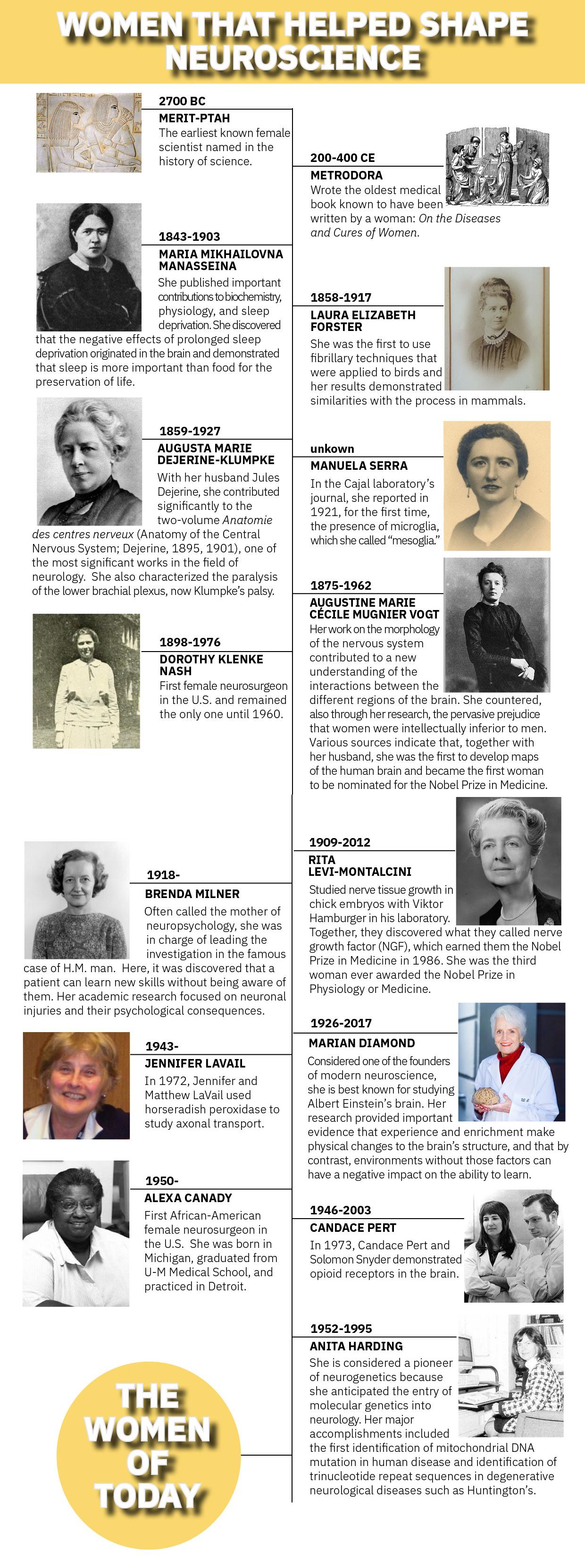
The Women:
Merit-Ptah (2700 B.C.)
Merit-Ptah was the earliest known female scientist named in the history of science.
Metrodora (200-400 C.E.)
Metrodora wrote the oldest medical book known to have been written by a woman: On the Diseases and Cures of Women.
Maria Mikhailovna Manasseina (1843-1903)
Maria Mikhailovna Manasseina published important contributions to biochemistry, physiology, and sleep deprivation. She discovered that the negative effects of prolonged sleep deprivation originated in the brain and demonstrated that sleep is more important than food for the preservation of life.
Laura Elizabeth Forster (1858-1917)
Laura Elizabeth Forster was the first to use fibrillary techniques that were applied to birds and her results demonstrated similarities with the process in mammals.
Augusta Marie Dejerine-Klumpke (1859-1927)
With her husband Jules Dejerine, Augusta Marie Dejerine-Klumpke contributed significantly to the two-volume Anatomie des centres nerveux (Anatomy of the Central Nervous System] (Dejerine, 1895, 1901), one of the most significant works in the field of
neurology. She also characterized the paralysis of the lower brachial plexus, now Klumpke’s palsy.
Manuela Serra
In the Cajal laboratory’s journal, Manuela Serra reported in 1921, for the first time, the presence of microglia, which she called “mesoglia.”
Augustine Marie Cécile Mugnier Vogt (1875-1962)
Her work on the morphology of the nervous system contributed to a new understanding of the interactions between the different regions of the brain. She countered, also through her research, the pervasive prejudice that women were intellectually inferior to men. Various sources indicate that, together with her husband, was the first to develop maps of the human brain and became the first woman to be nominated for the Nobel Prize in Medicine.
Dorothy Klenke Nash (1898-1976)
Dorothy Klenke Nash was the first female neurosurgeon in the U.S. and remained so until 1960.
Rita Levi-Montalcini (1909-2012)
Rita Levi-Montalcini studied nerve tissue growth in chick embryos with Viktor Hamburger in his laboratory. Together, they discovered what they called nerve growth factor (NGF), which earned them the Nobel Prize in Medicine in 1986. She was the third woman ever awarded the Nobel Prize in Physiology or Medicine.
Brenda Milner (1918- )
Often called the mother of neuropsychology, Brenda Milner was in charge of leading the investigation in the famous case of H.M. man. Here, it was discovered that a patient can learn new skills without being aware of them. Her academic research focused on neuronal injuries and their psychological consequences.
Marian Diamond (1926-2017)
Considered one of the founders of modern neuroscience, Marian Diamond is best known for studying Albert Einstein’s brain. Her research provided important evidence that experience and enrichment make physical changes to the brain’s structure, and that by contrast, environments without those factors can have a negative impact on the ability to learn.
Jennifer LaVail (1943- )
In 1972, Jennifer and Matthew LaVail used horseradish peroxidase to study axonal transport.
Alexa Canady
Alexa Canady was the first African-American female neurosurgeon in the U.S.
Candace Pert (1946-2003)
In 1973, Candace Pert and Solomon Snyder demonstrated opioid receptors in the brain.
Anita Harding (1952-1995)
Anita Harding is considered a pioneer of neurogenetics because she anticipated the entry of molecular genetics into neurology. Some of her major accomplishments included the first identification of the mitochondrial DNA mutation in human disease and identifying trinucleotide repeat sequences in degenerative neurological diseases such as Huntington’s.
Now
The women of today.
